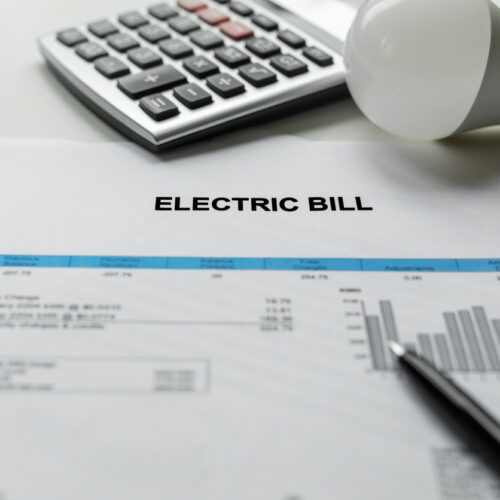Stressed young woman has financial problems with credit card debt to pay crucial show concept of bad personal money and mortgage pay management crisis. sad and unhappy

How Low-Income Customer Programs Lower Energy Costs for Everyone
Protecting vulnerable utility customers through proven programs reduces energy bill debt and reduces system-wide costs.
The latest data is out, and it doesn’t look good. Households across America are falling behind on their utility bills. According to a recent analysis from NEADA, household utility debt has risen from $17.5 billion at the end of 2023 to $23 billion as of June 30, 2025, an increase of 31 percent. As a result, 21 million households — roughly one in six — are behind on their utility bills, and shutoffs are projected to climb from 3.5 million in 2024 to as many as 4 million this year.
This is not only a household affordability challenge but also a system-wide one. Utility debt gets collected on the bills of all customers. Essentially, when your neighbor can’t pay for their utility bills, you end up paying it for them. Energy debt also contributes to service instability and deepens cycles of energy poverty. Public utility commissions (PUCs) are charged with ensuring safe and reliable service at just and reasonable rates, and today’s affordability crisis underscores the importance of that responsibility.
Evidence from multiple state programs shows that when commissions adopt affordability policies, they support vulnerable customers, reduce system-wide debt, improve payment behavior, and lower collection costs. Because there are less unpaid utility bills and collection costs that would eventually be recovered on all customer bills, these programs benefit participating customers while also putting downward pressure on the energy bills of all customers.
RMI’s role
RMI supports PUCs and consumer advocates in designing and implementing smart policies that lower system-wide costs and protect the most vulnerable customers. These programs reduce customer energy burdens and debts while reducing system-wide costs. Learn more at our Regulatory Resources Dashboard.
The promise of arrearage management plans (AMPs)
Arrearage (utility debt) management plans help customers eliminate past-due balances gradually while establishing regular payment habits, which can lead to lasting improvements in bill payment behavior. For participants, these programs create a clear and achievable pathway out of debt, restoring stability and reducing the stress of persistent arrears. A typical AMP might work like this: a customer with $600 of outstanding utility debt makes regular, on-time monthly bill payments, and in return the utility forgives one-twelfth of the arrears (or $50) each month, so that after a year of consistent bill payments the entire balance of debt is eliminated.
At least 10 states currently have active AMP programs. A 2021 evaluation of utility company Pepco’s AMP found that bill coverage rates for participating customers increased by 16 percentage points compared with nonparticipants, reduced average shortfalls by $370, and lowered late charges. Collection actions dropped from 36.7 actions per customer pre-enrollment to just 1.8 afterward — a net reduction of 4.2 compared with nonparticipants. These outcomes reduced customer hardship while also lowering bad debt charges and termination costs.
Percentage-of-income payment plans (PIPPs)
Percentage-of-income payment plans cap bills at a set proportion of household income, ensuring that customers are not charged more than they can reasonably afford and preventing arrears from accumulating. For participating households, this means predictable bills that fit within their monthly budgets, reducing the likelihood of falling behind and facing disconnection.
California’s PIPP pilot demonstrated measurable benefits in its first year: average arrears declined by $131 per household, and the share of participants with no past-due balance grew by 11 percentage points.
Low-income discount rates (LIDRs)
Discount rate programs reduce bills for income-eligible households. While less tailored than PIPPs, they are easier to administer and still provide meaningful relief. For customers, a lower monthly bill creates breathing room to cover other basic expenses while reducing the risk of utility shutoffs.
New York’s Energy Affordability Program has proven highly effective in reducing arrears and lowering the risk of service termination for low-income customers. During the pandemic (2020–June 2022), arrears for EAP participants rose by 50 percent, compared with an 89 percent increase for nonparticipants. According to the Public Utility Law Project, this difference saved the residential customer base an estimated $89 million in arrears relief. Without the program, arrears among participants likely would have grown at the same rate as nonparticipants, requiring an additional $380 million in relief, or $559 million when including carrying costs.
Another example comes from Indiana. A 2007 evaluation of the state’s Universal Service Program found that arrears occurred less often and were lower among those customers on the discount rate. At Citizens Gas, for example, average January arrears were $42 for participants compared with $100 for nonparticipants.
Low-income energy efficiency programs
Energy efficiency programs such as weatherization and appliance replacement lower bills for the lifetime of the efficiency action by reducing energy use. For customers, these investments improve comfort and safety in the home, while also helping to enable more affordable bills over the long term.
An evaluation of Pennsylvania’s Low-Income Usage Reduction Program (LIURP) for the 2021–2022 program year found that average net arrears fell by nearly $99 for PPL participants, $51 for PECO, $39 for Duquesne Light, and $25 statewide. These reductions were accompanied by declines in bad debt write-offs, showing how efficiency investments deliver system-wide benefits in the form of reduced bad debt in addition to the other system-wide and household benefits.
The bottom line: Supporting affordability for all
Programs such as AMPs, PIPPs, discount rates, and efficiency upgrades provide essential support to customers, reduce customers’ utility debt, and protect households from disconnection.
Importantly, these same programs also deliver system-wide benefits. They lower uncollectible balances, reduce costly collection actions, and strengthen overall affordability for all ratepayers. RMI analysis suggests that nearly half of the costs of these programs can be offset by reductions in utility debt alone.
The bottom line is clear: affordability programs protect the most vulnerable customers and reduce costs for all ratepayers. By advancing these policies, commissions can protect customers while ensuring a more stable and affordable energy system for all.

